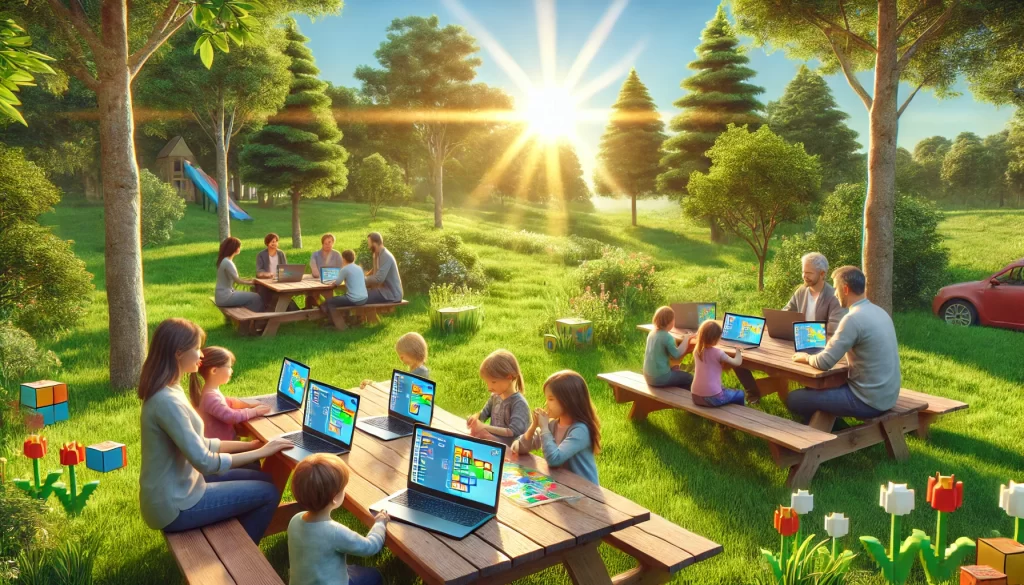A Fun and Simple Guide for Parents and Teachers

Have you ever wondered if kids can learn to code? Good news—they absolutely can, and it’s actually pretty fun!
I’ll never forget the first time my niece made a simple animation of a dancing penguin using Scratch. Her excitement lit up the room, and she couldn’t wait to show everyone.
Later, she even created a game about a flying cat saving the world! Teaching kids to code isn’t just for adults or tech experts. It can be easy and exciting for everyone.
Why Teach Kids Coding?
You might be wondering why kids should learn coding. Isn’t school challenging enough already? Well, coding lets kids create anything they can imagine, from games to animations. It’s like giving them superpowers!
Coding helps kids become better problem-solvers and creative thinkers. It also improves their math and logic skills.
How? By teaching them to break problems into smaller parts, spot patterns, and think step-by-step. Plus, knowing how technology works will prepare them for the future.
Start Early, Start Simple
Ready to dive in? Awesome! But don’t start with complicated languages like Java or Python just yet.
Begin with easy-to-use coding tools designed specifically for kids. Programs like Scratch or Blockly use colorful blocks kids can connect, just like Legos. This makes coding simple and fun.
Have you ever solved a puzzle or built something amazing? Coding feels just like that—but digital.
Imagine building a digital LEGO masterpiece, like your own city, spaceship, or robot. Every puzzle solved is like adding another LEGO brick.
Soon those digital bricks become cool games or animations your child can proudly show off.
Follow Their Interests
Does your child love Minecraft? My friend’s son does!
He started coding by creating his own mods and designing worlds with Minecraft Education Edition. Connecting coding with something kids already love makes learning fun.
Kids who enjoy storytelling can also create interactive stories using tools like Scratch and Twine. It helps coding feel more like storytelling than homework.
Mistakes Are Learning Opportunities
Mistakes happen all the time in coding—and that’s perfectly okay!
If your child gets frustrated, gently ask, “What do you think we can try next?” This helps them feel involved and turns frustration into a fun challenge.
Once, my niece got upset when the cat in her game wouldn’t move. We laughed, checked her code, and found she had accidentally programmed it to fly backwards!
Mistakes in coding are just like learning to ride a bike or baking cookies. If something doesn’t work, you don’t quit—you try again and learn more each time.
Short and Sweet Sessions
Keeping sessions short is key. Limit coding lessons to just 15-20 minutes.
Aim for regular sessions several times a week, ideally daily or every other day. Short, frequent practice keeps coding fun, not overwhelming.
Regular, short sessions always beat long, tiring ones.
Learn Together
New to coding yourself? Great!
Learning alongside your child can be a fantastic bonding experience. There are plenty of easy-to-follow tutorials and videos online.
Exploring together builds confidence and makes coding less scary and more enjoyable.
Use Real-Life Examples
Make coding concepts easier by comparing them to everyday activities. Algorithms are like recipes.
Loops are tasks you repeat daily, like brushing teeth, and debugging is similar to finding misplaced items. Think of coding as planning a birthday party.
You follow steps (algorithms), repeat tasks like sending invitations (loops), and when something goes wrong, you fix it—just like finding the missing birthday candles!
Celebrate Every Achievement
Did your child create their first game or animation? Celebrate it!
Every little success matters and deserves recognition. Celebrating achievements helps kids feel proud and excited to keep coding.
Ready to start your coding adventure? Let’s jump right in—it’s easier and way more fun than you think!

Leave a Reply
You must be logged in to post a comment.